- Quick Read
- Deep Read ( 13 Min. )
In Today’s Issue
Monitor Daily Podcast
- Follow us:
- Apple Podcasts
- Spotify
- RSS Feed
- Download
TODAY’S INTRO
Free college tuition? How restaurants are recruiting new workers.
There are all sorts of ways to get America back to work.
In recent days, the Republican governors of Alabama, Arkansas, Iowa, Mississippi, Missouri, Montana, North Dakota, South Carolina, Tennessee, and Wyoming announced they are ending the $300 per week federal pandemic-relief unemployment benefits provided on top of state assistance. “It’s time for everyone who can to get back to work,” Iowa Gov. Kim Reynolds said Tuesday, while noting the state has a 3.7% unemployment rate.
While some states are cutting benefits, Skyler Reeves is boosting them. Go to work at one of the five restaurants Mr. Reeves owns in Prescott, Arizona, and after three months working full time, he’ll pay the full tuition ($2,492) at Yavapai College, a local community college.
Such tuition assistance programs are increasingly common at big chains, such as Starbucks, Chipotle, and McDonald’s. As the Monitor reported, restaurants are struggling to find workers, and are turning to creative incentives, including signing bonuses of $3,000. The Illinois-based Portillo’s Hot Dogs chain is offering $250 hiring bonuses, paying social media influencers to promote openings, and driving around a “beef bus” to help recruit workers, reports The Wall Street Journal.
Is Mr. Reeves’ tuition offer working? In the first week, the number of job applicants went from zero to 20 people. He tells ABC15-TV in Phoenix, “I’ve always wanted to have a company where people really want to come work for it.”
Share this article
Link copied.

Help fund Monitor journalism for $11/ month
Already a subscriber? Login

Monitor journalism changes lives because we open that too-small box that most people think they live in. We believe news can and should expand a sense of identity and possibility beyond narrow conventional expectations.
Our work isn't possible without your support.
A deeper look
Is politics the new religion?
What do Americans worship? Our reporter finds that political followers are embracing conservative or liberal values – and communities – with the same moral certainty and devotion once given to religion.

American membership in houses of worship has plummeted to below 50% for the first time in eight decades of Gallup polling, from 70% in 1999 to 47% in 2020. And that shift away from organized religion has dovetailed with the rise of an intense form of partisan politics that some see as quasi-religious – providing adherents with a sense of devotion, belonging, and moral certitude.
From MAGA devotees on the right to social justice warriors on the “woke left,” political activism that can feel “absolute” in a religious way is rampant.
Especially among young people, “if your candidate wins, you have that ecstatic feeling,” says Ryan Burge, an expert on religion and politics at Eastern Illinois University who is also a Baptist pastor. A stump speech can feel like a tent revival. Donating regularly to candidates is like tithing.
Why is this happening? Some point to social media and news consumption habits that have cordoned Americans off into ideological echo chambers. The sense of connection some find online may be replacing social networks once formed by houses of worship. A cultural emphasis on science and “rationalism” is also a factor.
“Our politics has become religion. It has a religious fervor to it now that it didn’t have even 20 or 30 years ago,” says Professor Burge.
Is politics the new religion?

Mandy will always remember Jan. 6, 2021, in a deeply personal way. Because she was there, inside the U.S. Capitol, supporting her president.
The images she saw that day remain sharp: The giant American flag carried by the crowd as they marched from the Ellipse. Singing “The Star-Spangled Banner” on the Capitol steps. And finally, entering the building through open doors and standing peacefully in its cavernous Rotunda.
She’s aware of the videos showing mob violence. But that must have been on the other side of the Capitol, she says. For her, it was a day of jubilation, of like-minded people joined in common purpose to “stop the steal” of the 2020 election.
“This was probably the most patriotic day of my life,” says Mandy (not her real name), who asks to remain anonymous so as not to risk her job. With a Facebook page that’s a hub of pro-Trump connections, she says she’s traveled to 21 rallies for now-former President Donald Trump since 2016. “I go for the people as much as I do for Trump.”
Similar stories of secular communion have given rise to a theory that has gotten considerable attention of late: that for many Americans, politics has become a quasi-religion – especially as participation in actual, organized religion has plummeted. Indeed, Mandy says she believes in God, and grew up Southern Baptist, but is not currently a churchgoer.
The United States has long been known for what some sociologists call “civil religion” – a shared, nonsectarian faith centered on the flag, the nation’s founding documents, and God. But the God factor is waning, as so-called nones – atheists, agnostics, and those who self-identify as “nothing in particular” – have risen to one-third of the U.S. population, according to a major 2020 survey out of Harvard University.
From MAGA devotees on the right to social justice warriors on the “woke left,” political activism that can feel “absolute” in a quasi-religious way is rampant. At the same time, American membership in houses of worship has plummeted to below 50% for the first time in eight decades of Gallup polling – from 70% in 1999 to 47% in 2020.
And as American politics has become polarized, so too has the nation’s religious profile. The mainstream Protestant center has hollowed out, its population shrinking dramatically. Today, religious Americans tend to choose their congregation with an eye toward partisanship – to the point where the choice of presidential candidate can lead a voter to move to a new church.
“Liberals and ‘nones’ went to the left; conservatives and Evangelicals went to the right,” says Ryan Burge, an expert on religion and politics at Eastern Illinois University, and author of a new book called “The Nones.” “There’s no middle anymore.”
Atheists, he says, are now the most politically active group in the U.S. They’re far from the largest, at 6% of the population, but statistically they are the most likely to engage in political activity.
“Our politics has become religion. It has a religious fervor to it now that it didn’t have even 20 or 30 years ago,” says Professor Burge, who is also a Baptist pastor.
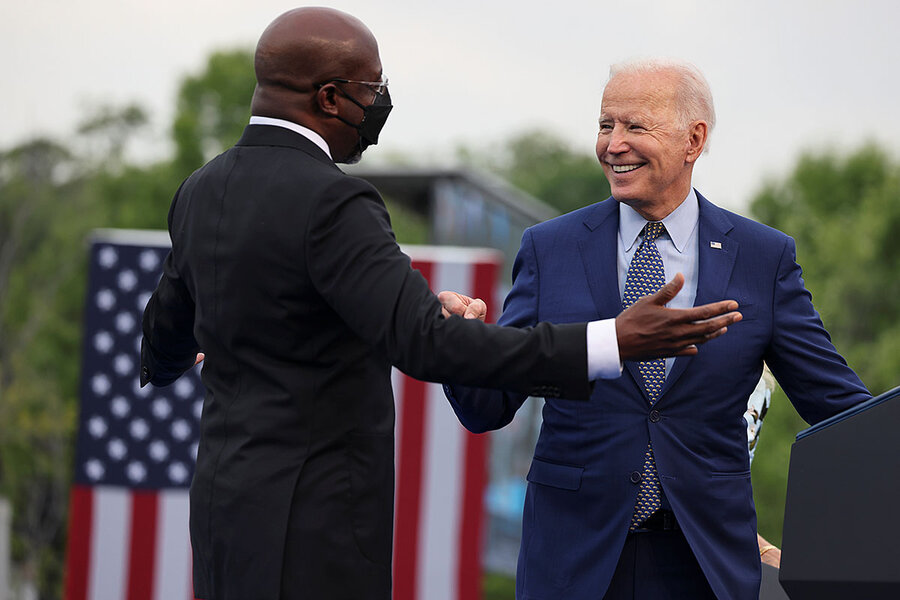
Why is this happening? Some point to social media and news consumption habits that have cordoned Americans off into ideological echo chambers that are all-consuming and provoke emotional responses. The sense of connection some find online may be replacing social networks once formed by houses of worship.
Geographic sorting, in which people tend to live near those with similar political views, is another component. Higher education, dominated by an increasingly secular culture, may help explain why so many college-educated young people now reject religion, with some instead finding a sense of purpose and meaning in political activism. A cultural emphasis on science and “rationalism” is also a factor.
Still, there’s a lot of nuance. President Joe Biden, a practicing Roman Catholic, is the first American president since Jimmy Carter to attend church regularly. In general, people of faith – particularly in the Black community – remain a key component of Democratic politics. Newly elected Georgia Sen. Raphael Warnock was the senior pastor at Ebenezer Baptist Church in Atlanta, where the Rev. Martin Luther King Jr. preached.
Unlike the 1960s civil rights movement, however, the main leadership of today’s Black Lives Matter movement did not spring from Black churches. And the same forces driving down religious participation among young Americans, in particular, are also affecting Black churches. Between 2008 and 2020, religious disaffiliation among African Americans soared from 17.7% to almost 35%, according to the Harvard study, known as the Cooperative Congressional Election Survey (CCES).
Even for Americans of faith, the role of traditional houses of worship is shifting. The pandemic has given rise to “online church,” allowing some congregants to find a spiritual home far from their physical home. But the larger trend is clear: Americans overall are moving away from organized religion, particularly the mainline faiths. And that shift has dovetailed with the rise of an intense form of partisan politics that some see as quasi-religious, providing adherents with a sense of devotion, belonging, and moral certitude.
Especially among young people, “if your candidate wins, you have that ecstatic feeling,” Professor Burge says. Political conventions can have the feel of old-time denominational meetings. A stump speech is like a tent revival. Donating regularly to candidates is like tithing.
Still, he suggests, some who eschew religion in favor of politics may ultimately find it lacking in certain ways. Politics “doesn’t have the legs that religion does – which carries you through all parts of life.”
Finding a spiritual home
For Bentley Hudgins, a nonbinary Asian American community organizer in Atlanta, it was the realization of their gender identity that drove them from the Southern Baptist church they had attended through childhood and into college. Until that break, the church seemed a positive force in their life.
Bullied in school, “I found refuge in the structure of a church,” Mx. Hudgins says. “People told you that you were judged by the content of your character, and that your job on this earth was to make people feel loved. That message was compelling to me.”
As Mx. Hudgins came to terms with their gender identity and the church’s nonacceptance, separation from that community shook their world. Yet in many ways, the core of Christian teachings still permeates Mx. Hudgins’ life and work.
“This radical love of Christ is something that is still a model for my activism,” Mx. Hudgins says. “If people are hungry, feed them. If people need healing, give them health care.”
Mx. Hudgins is far from alone as a young adult for whom some of the basic themes of Christian teachings have instead been channeled into nonreligious forms of activism.

“A lot of people my age have found our spiritual home in the movement to restore and expand civil rights,” they say.
It has become a cliché to suggest that atheism is itself a form of “religion.” Writer Andrew Sullivan, who is gay and Roman Catholic, maintains that “everyone has a religion,” that it’s “in our genes.” Seventeenth-century mathematician and theologian Blaise Pascal conceptualized what in Christian circles became known as “the God-shaped hole” – the idea that all humans contain an “infinite abyss” that can only be filled by “an infinite and immutable object; in other words by God himself.”
Calling partisan politics a form of “religion” can be offensive to believers and nonbelievers alike, as it seems to equate human activity with the spiritual. And not surprisingly, most atheists reject the use of the word “religion” to describe their beliefs. But many are well aware of their growing influence in American society as a political force.
Annie Laurie Gaylor, co-president of the Freedom From Religion Foundation (FFRF) – which runs ads featuring Ron Reagan, son of the former president – argues that atheists, agnostics, and otherwise nonreligious people have in the past been woefully underrepresented in public life.
That’s changing as their numbers rise. Ms. Gaylor ascribes this shift in part to “antiquated” attitudes in some churches toward women and LGBTQ people, which have turned young people in particular away from organized religion.
“We are seeing our country waking up, as it had already in much of Europe and the U.K.,” Ms. Gaylor says. “It took a long time, but once you turn that light switch on, I don’t think you turn it back off.”
For members of Congress, where a stated religious affiliation has long been near-universal, that’s changing. In 2018, the Congressional Freethought Caucus was founded to promote public policy “based on reason and science” and “to protect the secular character of our government.”
Today the group has 14 members, all House Democrats, or 2.6% of the 535 members of both chambers. While that’s still a small percentage, those numbers in Congress – and in politics in general – seem almost certain to rise as younger generations grow into positions of power.
Acceptance of nontheistic thought is growing. Yet activists say they can still get shocked looks when they identify themselves as atheists.
“My theory is that a lot of people were taught by churches that atheists are bad, believe in the devil, and have no morals,” says Judy Saint, a retired math teacher who started the FFRF chapter in Sacramento, California. “We have our morals from inside, not from outside.”
FFRF advocates on issues such as tax preferences for religious groups and end-of-life laws. And members participate in secular efforts to help people in need. But there are times when an FFRF activity can, in fact, seem quasi-”religious” to some. In Sacramento, during the December holidays, the local chapter puts up a display on the State Capitol grounds that looks like a Nativity scene. It features the Founding Fathers signing the Bill of Rights – which was ratified in December 1791. A Christian Nativity scene sits nearby.
“Worshipping at the altar of politics”
During President Trump’s time in office, even high-profile supporters asserted at times that he had been chosen by God to serve. “I think God calls all of us to fill different roles at different times, and I think that He wanted Donald Trump to become president,” press secretary Sarah Huckabee Sanders said in 2019. Energy Secretary Rick Perry called him God’s “chosen one.”
That belief grew markedly among conservatives in his final year in office. Among white Protestants who attend church at least weekly, the portion who said Mr. Trump had been “anointed by God” to be president rose from 29.6% in May 2019 to 49.5% in March 2020, according to polling by Paul Djupe of Denison University and Professor Burge.
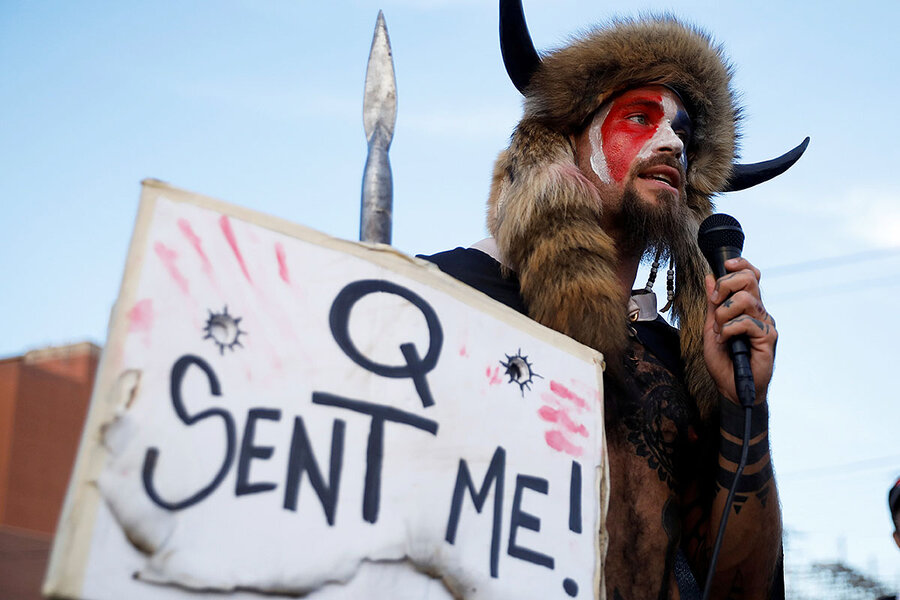
QAnon – the online theory that a satanic ring of pedophiles was operating inside the “deep state” to undermine the Trump presidency – also gained considerable currency on the right. At its height, it may have functioned as a quasi-religion for some believers. Adherents of QAnon were prominent among the Capitol invaders, though the theory seems to have faded somewhat since Mr. Trump left office.
All the Christian imagery and objects present at the Capitol insurrection suggested another cultural trend. Crosses, Christian flags, Bibles, and signs equating President Trump and Jesus – along with the presence of Confederate flags and antisemitic slogans – exposed the “comfortable juxtaposition” of Christian and white nationalist imagery, says Robert P. Jones, CEO of the Public Religion Research Institute.
He rejects the idea that politics is replacing religion in America, instead characterizing the prevailing political dynamic as tribalism. “What we see is an overwhelmingly white and Christian reaction to the changing demographics and culture of the country,” says Dr. Jones, author of the book “White Too Long: The Legacy of White Supremacy in American Christianity.”
Even if the focus today is more on political tribalism than on religious practice, some observers warn we may be heading down a path toward full-on sectarian conflict – a threat to democracy itself.
“Whether religious or political, sectarianism is about two hostile identity groups who not only clash over policy and ideology, but see the other side as alien and immoral,” writes Nate Cohn, a polling expert at The New York Times. “It’s the antagonistic feelings between the groups, more than differences over ideas, that drive sectarian conflict.”
Mainstream evangelical leaders who support Mr. Trump recognize the risk that far-right extremism poses to their community’s image. Tony Perkins, president of the Family Research Council and an informal adviser to Mr. Trump during his presidency, has consistently condemned the assault on the Capitol – and makes clear in an interview that not all Trump supporters are alike.
Those on the right whom he calls “SAGE Cons” – spiritually active, government-engaged conservatives – know how to “keep things in perspective,” Mr. Perkins says. “Their allegiance to Trump was based on his policies, such as abortion and religious liberty. It’s not a personality cult, as some would like to explain it.”
“You have people saying, ‘Evangelicals are making politics their religion,’” he adds. “We’re just responding to what the left has been doing – worshipping at the altar of politics.”
The Great Awokening
In liberal neighborhoods across the country, a rainbow-hued sign can be seen dotting lawns. It proudly lists a set of principles: “In this house we believe: Black lives matter; Women’s rights are human rights; Love is love; Science is real,” and so on.
Peter Juul of The Liberal Patriot calls it “the Nicene Creed and shahada of the new religion of progressive politics.”
“It’s a faith that’s rapidly won converts at the highest levels of American politics and society,” Mr. Juul writes, “one that uncannily mirrors much of the thinking and many of the practices of its ancient predecessors, complete with its own dogmas, heresies, and rituals as well as apocalypses and forms of mysticism.”
Dating back to Colonial times, religious “awakenings” in America have come and gone. At times of upheaval, a flocking to religion has often been a central feature.
“The Civil War was in many ways fought and understood in religious terms on both sides,” says Tisa Wenger, associate professor of American religious history at Yale Divinity School.
During the Cold War, too, existential anxiety – driven by fear of nuclear weapons and “Godless communism” – led to another rise in religious affiliation in the U.S.
Today, amid a once-in-a-century pandemic, major economic disruption, and upheavals around issues of race and sex, the reverse is underway. Instead of another “Great Awakening,” America is experiencing what some have dubbed the “Great Awokening” – centered on calls for social justice.
The term “woke,” slang for “awake,” came into common usage with the birth of Black Lives Matter in 2013 and became further entrenched last year after the murder of George Floyd by a white police officer in Minneapolis, sparking a summer of racial unrest.
“There’s a real wrestling right now on the left with trying to negotiate new cultural norms, in which casual racism and homophobia should no longer be acceptable,” Professor Wenger says.
At heart, “woke” refers to awareness of racial and social justice issues. Increasingly, however, it has been weaponized by conservatives mocking what they see as excesses on the left.
Even some Democrats express concerns about the larger movement promoting “anti-racism.” John McWhorter, an African American linguist and social critic at Columbia University, describes white people’s expressions of “wokeness” as a form of virtue-signaling that has morphed into a misguided civic religion.
“White people – educated white people, especially – really enjoy the idea of showing that they’re not racists,” Professor McWhorter said in a recent discussion with Reason magazine. “It has slowly transmogrified into a kind of replacement for Protestantism ... where your grace is that you are not a racist.”
Some observers draw a straight line from the Puritans of Colonial times to the “woke scolds” of today who are quick to “cancel” transgressors and see no room for grace and forgiveness. Indeed, enforcement of progressive standards today can seem even harsher than Christianity’s approach, which allows space for sinners to atone and be given another chance.
Still, progressives argue it’s important not to lose sight of the goal of the “anti-racist” movement, which is to expose and uproot injustices that have been entrenched in U.S. society throughout its history.
Human belief systems can be complicated. Professor Burge, the political scientist who is also a Baptist pastor, sees some hope in the data. Yes, the “nones” are a rising cohort in the nation’s religious landscape. But stating a lack of religious affiliation has also become far more socially acceptable, so in reality the shift may be less dramatic than it seems.
Among those who checked off “nothing in particular” on the CCES survey on religion in the Harvard study in 2010, follow-up interviews over four years showed that 1 in 6 migrated toward a Christian tradition.
And some young adults today have never left their church. Joey Wozniak, of Atlanta, is a civically minded 20-something who belongs to an Episcopal congregation. Its membership skews older, he says, but there are others his age.
While the pandemic has made it hard to stay active in his church, he says he’s applying its basic tenets to his work, which is nonpartisan but in the realm of politics. His religious convictions have reinforced certain principles, such as “being respectful to people, being kind to others, reaching out across differences, reconciling with folks.”
“I try to just listen to them and find out where they’re coming from,” he says. “Somehow, even amongst the political rancor of today, I’m still able to move forward with those convictions and try to find the common ground.”

The Explainer
Is there a US gas shortage? Three questions about pipeline hack.
Panic-buying over fear of a gasoline shortage can be a self-fulfilling act. Our reporters offer a calm look at the Colonial Pipeline ransom attack.

- Quick Read
- Deep Read ( 6 Min. )
-
Dwight Weingarten Staff writer
Cyberattacks may seem an abstract threat to many Americans. But the ransomware strike that knocked offline a key gasoline pipeline last week has created concrete problems for drivers in the Southeast as fuel prices creep up and lines form at service stations in affected areas.
The pipeline came back online Wednesday evening, Energy Secretary Jennifer Granholm announced. But the shutdown of the Colonial Pipeline system underscores the continued vulnerability of important sections of the country’s infrastructure to foreign hackers seeking chaos or cash, or both. Many potential targets of cyber extortion haven’t invested enough in computer security in recent years, say some experts. Meanwhile, the explosion of remote work during a pandemic has created more holes where bad actors can break into systems.
“With this pipeline incident, it will hit Americans in the pocketbook at the pump,” says Tony Turner, vice president of security solutions at Fortress Information Security, a Florida-based company that specializes in the security of critical infrastructure. “Colonial was negligent in their responsibilities to properly secure their environment, and all of us are paying for it.”
Is there a US gas shortage? Three questions about pipeline hack.
Cyberattacks may seem an abstract threat to many Americans. But the ransomware strike that knocked offline a key gasoline pipeline last week has created concrete problems for drivers in the Southeast as fuel prices creep up and lines form at service stations in affected areas.
The pipeline came back online Wednesday evening, Energy Secretary Jennifer Granholm announced, although it is expected to take several days to become fully operational. But the shutdown of the Colonial Pipeline system underscores the continued vulnerability of important sections of the country’s infrastructure to foreign hackers seeking chaos or cash, or both. Many potential targets of cyber extortion haven’t invested enough in computer security in recent years, say some experts. Meanwhile, the explosion of remote work during a pandemic has created more holes where bad actors can break into systems.
“With this pipeline incident, it will hit Americans in the pocketbook at the pump,” says Tony Turner, vice president of security solutions at Fortress Information Security, a Florida-based company that specializes in the security of critical infrastructure. “Colonial was negligent in their responsibilities to properly secure their environment, and all of us are paying for it.”
What happened?
Last Friday, Colonial Pipeline shut down its 5,500-mile-long East Coast gasoline pipeline due to cyberattack. The pipeline, which runs from Houston to the New York City area, provides the eastern section of the United States with almost half of its transportation fuel.
The firm acknowledged on Saturday that its corporate computers had been hit by a ransomware attack, in which a criminal organization encrypts a target’s computer data, essentially holding it hostage until the target pays a ransom. The pipeline was shut down apparently as a precaution to block the malware affecting the corporate data from traveling into its pipeline control system, with potentially far-reaching results.
On Monday, the FBI said that a relatively new hacking group based in Eastern Europe or Russia called DarkSide was behind the attack. In brief comments on the subject, President Joe Biden said that the Russian government did not appear to be behind the attack. However, he criticized Russian authorities for tolerating criminal hacker groups that target non-Russian corporations and governments.
“They have some responsibility to deal with this,” said President Biden.
A group purporting to be DarkSide posted its own statement on the clandestine dark web following the U.S. revelations. It sounded a bit surprised, as if it was not aware of the implications of taking down such an important target.

“Our goal is to make money, and not creating problems for society,” the statement said in part.
Is there a gas shortage?
The Colonial Pipeline attack could have been worse. Pipeline controls appear largely unaffected. Gasoline and jet fuel are very important products, but perhaps not as important as natural gas for furnaces piped into the Northeast in the winter.
“Overall, natural gas provides 40% of American electrical power production, so this is a significant incident, but not near as critical as an incident could [have been] involving pipelines,” says Mark Montgomery, senior adviser to the chairmen of the Cyberspace Solarium Commission, a congressionally mandated group created to devise a strategy for the nation in cyberspace.
That said, the interruption of gas, diesel, and jet fuel supplies comes at a time of year when travel generally begins to increase – and at a time when the pandemic appears to be abating, potentially releasing a huge pent-up national demand for mobility.
Gas prices were already rising – up 6 cents per gallon over the past week, AAA said on Monday – and the ransomware attack may have been pushing them higher still, particularly in the Southeast and mid-Atlantic. Mississippi, Tennessee, and the East Coast from Georgia to Delaware are likely to experience limited fuel availability and extra price hikes, according to AAA.
Panicked buying in areas affected by the pipeline shutdown made things worse, as hoarding drained gas stations dry of reserves. As of Wednesday afternoon, 65% of all gas stations in North Carolina, and 42% in Georgia, Virginia, and South Carolina, were without gasoline, according to GasBuddy, an app that tracks fuel availability and price.
The situation was even worse in metro areas, with some 75% of stations in Raleigh and Charlotte, North Carolina, out of fuel.
Seen in a national context, there is not a shortage of gasoline per se, said AAA spokeswoman Jeanette McGee. There is a transportation problem, with a short-term inability to deliver gas to everywhere it’s needed.
“There is ample supply to fuel the United States for the summer, but what we’re having an issue with is getting it to those gas stations because the pipeline is down,” said Ms. McGee.
Are ransomware attacks increasing?
Ransomware isn’t new. Its first documented use was in 1989 with the PC Cyborg virus, which was transmitted from computer to computer on infected floppy disks, according to a 2017 study of ransomware published by the director of national intelligence.
But U.S. officials believe that it is a particularly malicious type of attack that is liable to make up a larger and larger percentage of the cybercrime directed at vulnerable companies, hospitals, police forces, and other institutions.
Globally, some 1,300 companies experienced ransomware attacks in 2020, according to a study from Emsisoft, an antivirus software firm. In the U.S,. 2,354 schools, hospitals, and government entities were similarly targeted.
Earlier this week, for instance, a hacker group named Babuk that had infiltrated the D.C. Police Department’s computers began releasing personnel files of individual officers, and said that it would publish information on sensitive investigations and informants unless the district government paid it a ransom. Such a slow increase in pressure is a common feature of a ransomware attack.
Critical infrastructure such as pipelines, electrical grids, and water treatment plants may be particularly vulnerable to ransomware.
For them the stakes involved in an attack may be high. Imagine hackers gaining control of a water plant and remotely increasing the percentage of chlorine added to the water – an attack successfully simulated by Georgia Institute of Technology researchers, according to the DNI ransomware report. And many infrastructure computer systems are patchworks created over years, by institutions that did not sufficiently invest in cyber defense.
“Broadly, we have found in a lot of infrastructure that didn’t feel the pressure of criminal behavior 10 or 15 years ago, they did not make that investment. And that’s why we’re vulnerable today,” says Mr. Montgomery of the Cyberspace Solarium Commission.
The Justice Department has formed a task force to try to stop the growing ransomware trend. The point is to develop a strategy to attack the entire ecosystem that allows ransomware groups to thrive. That means identifying links between national governments and ransomware groups, prosecuting those responsible, and curbing services that support the crime, such as online forums where ransomware providers advertise their services.
President Biden also issued an executive order Wednesday, planned since early in his administration, to implement new digital safety standards in the federal government. The order also aims to remove barriers to information-sharing between government and the private sector, improve the security of software supply chains. and standardize the response to cyber incidents.
“While we expect companies to secure their infrastructure, these continued breaches only reinforce the need for a cohesive and cooperative partnership between the government and private companies that operate our nation’s critical infrastructure,” said Sen. Mark Warner, Democrat of Virginia and co-chair of the bipartisan Senate Cybersecurity Caucus, in an email to the Monitor.
“There’s been various discussions on the Hill regarding mandatory breach notification,” said a senior administration official in a press call discussing the executive order. “It’s hard to learn from each incident and ensure that broadly government and companies have information to protect themselves. So we’ve pushed the authority as far as we could and said anybody doing business with the U.S. government will have to share incidents so that we can use that information to protect Americans more broadly.”

Patterns
Liz Cheney’s ouster stirs doubts abroad about health of US democracy
Europeans have seen what happens when democratic principles in Germany and Poland were undermined. Our columnist says now they wonder if they’re watching the integrity of American democracy erode from within.
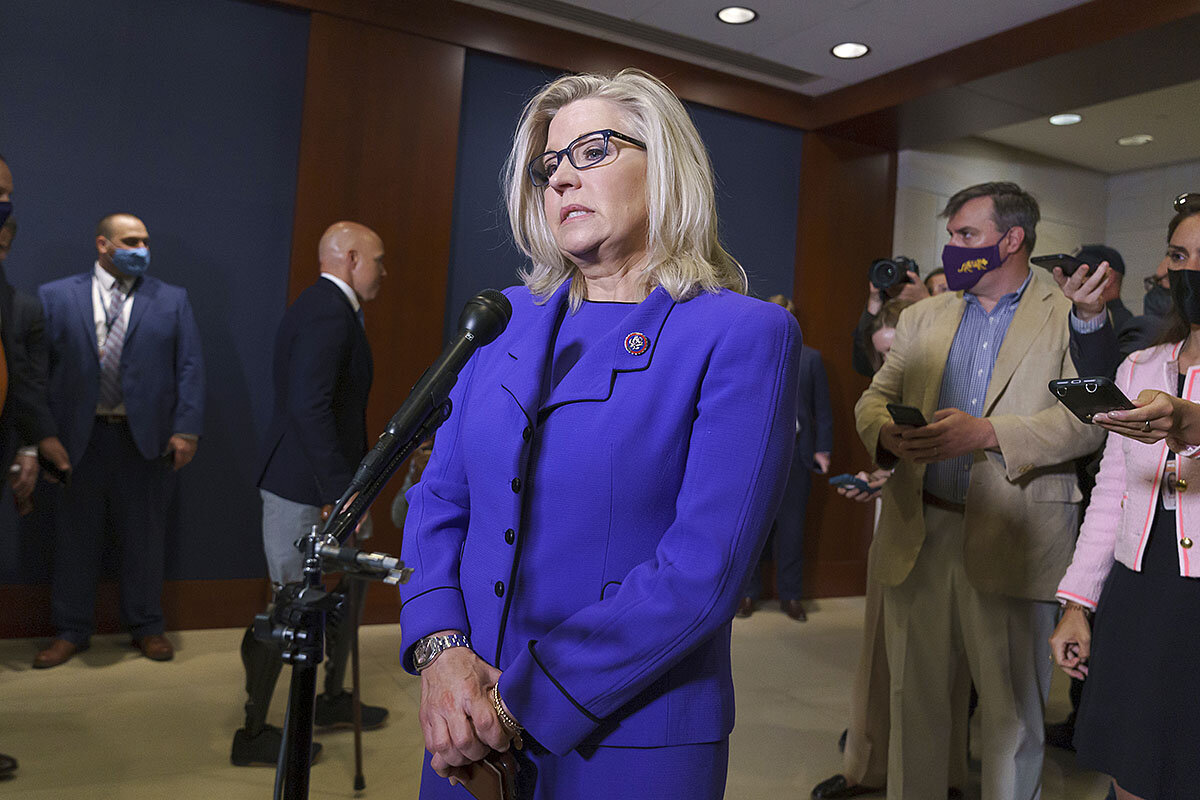
- Quick Read
- Deep Read ( 4 Min. )
Rep. Liz Cheney’s ouster from a top leadership post in the Republican Party has drawn attention, and concern, a long way from her home state of Wyoming.
America’s overseas allies, especially in Europe, are as worried as Ms. Cheney about the direction of U.S. democracy. They wonder whether the Republicans are abandoning their traditional policy and political role in favor of personal allegiance to a leader in the populist, strongman mode: former President Donald Trump.
Ms. Cheney is under fire for refusing to support Mr. Trump’s false claim that he won the election last November. International allies share her concern that such claims could undermine the U.S. tradition of peaceful transitions from one administration to the next.
And Europeans recall the bitter price they paid for personal fealty to an unchallenged leader. Mr. Trump is clearly no Adolf Hitler, but in Mr. Trump’s path to unquestioned control of his party, some hear echoes of the German dictator’s rise to power.
There’s another reason for allied concern. President Joe Biden plans to lead U.S. partners in reasserting shared values in the face of rising autocracies such as China. It will be difficult to fight that battle credibly if America’s own democracy appears in crisis.
Liz Cheney’s ouster stirs doubts abroad about health of US democracy
The world is watching Wyoming.
Not because of its undeniable natural beauty: jewels like the Grand Tetons and Yellowstone, Jackson Hole or Flaming Gorge. It’s because of Wyoming’s lone member of the House of Representatives, Liz Cheney, and her fears about the direction of the Republican Party and, more widely, of American democracy.
America’s overseas allies, especially longtime partners in Europe, share those fears.
Their concern has been percolating since election night in November, when prominent European politicians took the extraordinary step of voicing public alarm over Donald Trump’s premature declaration of victory and his call for a halt to the vote count.
But Europeans’ anxiety – informed by their Continent’s own experience, historical and contemporary, of how democratic institutions can erode from within – goes deeper.
They wonder whether the Republicans – one of the two major parties in the most durable and influential democracy in the modern world – may be on the way to definitively abandoning their traditional political and policy role in favor of personal allegiance to a leader in the populist, strongman mode.

Representative Cheney’s refusal to support former President Trump’s insistence that he actually won the election six months ago, and her vote to impeach Mr. Trump over the Jan. 6 insurrection at the U.S. Capitol, led to her removal as GOP conference chair when House Republicans convened Wednesday.
But international allies share her view that perpetuating Mr. Trump’s false claims about the November election could have implications for future elections and for a central pillar of U.S. democracy: the tradition of peaceful transfer of power by consensus from one administration to the next.
For Europeans, the potential implications of personal fealty to an unchallenged leader are not just theoretical. They’ve experienced them at great cost in the past and are seeking to avert them even now – cautionary examples powerfully brought home in two books I’ve been rereading in recent days: William L. Shirer’s magisterial “The Rise and Fall of the Third Reich” and journalist Anne Applebaum’s more recent “Twilight of Democracy,” with its insights into the ways that the post-Soviet democratic system in present-day Poland has frayed.
Mr. Trump, obviously, is no Adolf Hitler. Yet in his path to unquestioned control of his party, some Europeans hear echoes of the German dictator’s rise to power. Yes, intimidation and violence played a major role in Hitler’s ascent. But at key moments, politicians from his own and other right-of-center parties simply surrendered to the leader’s will and agenda. In Mr. Shirer’s trenchant phrase, they “passed quietly, unprotestingly out of existence.” Policy became whatever Hitler said it was.
In America’s clearly quite different context, Ms. Cheney is warning against Republican policy becoming, in effect, whatever Mr. Trump says it is – a trend that was becoming evident even before the election, when the Republican Party convention, for the first time in its history, did not even bother to adopt a new policy platform.

Yet it is modern-day Poland and neighboring post-Soviet Hungary that may provide more direct European parallels. In both countries, governing center-right parties have fallen behind what their leaders have unapologetically dubbed “illiberal democracies” that have tightened controls over the judiciary, the media, universities, and other independent voices.
Eastern European “illiberalization” has not relied only on fiat or intimidation. As Ms. Applebaum explains, it has involved a wholesale shift of worldview – among politicians and other opinion-formers previously championing democracy – to embrace a narrow, populist, and ultimately anti-democratic project.
One reason that Wyoming is on American allies’ political radar is their antipathy to Mr. Trump himself. That’s in part because he often denigrated, and generally pulled back from, long-standing U.S. alliances overseas.
The current trend toward a Trump-defined Republican Party has raised doubts in their minds about the staying power of President Joe Biden’s assertion of a more familiar American role in the world. Can this promotion of democracy and support for U.S. alliances be assumed from one election to the next?
The very fact that Ms. Cheney has been waging her one-woman battle against a fully Trump-loyal party is a reminder that the argument may not be over.
One reason for the overwhelmingly pro-Trump cast of Republican legislators today is that the former president remains highly popular with many of their voters. It’s a practical political choice. That could conceivably change, depending on the former president’s political stock in the months and years ahead.
But one thing is certain for now: One-half of America’s two-party system is lending credence to Mr. Trump’s untruths about the election result, and is reluctant to discuss, much less investigate, January’s invasion of the Capitol. And that raises a more immediate problem for Mr. Biden and for U.S. allies.
The new president is determined to lead America’s partners in reasserting shared values and, given their rivalry with an ever-more assertive, authoritarian China, to meet what he has called the defining challenge of our age: the contest between democracy and autocracy.
It will be difficult to fight that battle credibly if America’s own democracy appears in crisis.

Difference-maker
The Travelling Telescope brings stars to students
Making the night sky accessible to all Kenyans can be a gateway for science, math, and creative thinking. The goal of this project, our reporter found, is less about creating astronomers than inspiring young people to be passionate about learning.
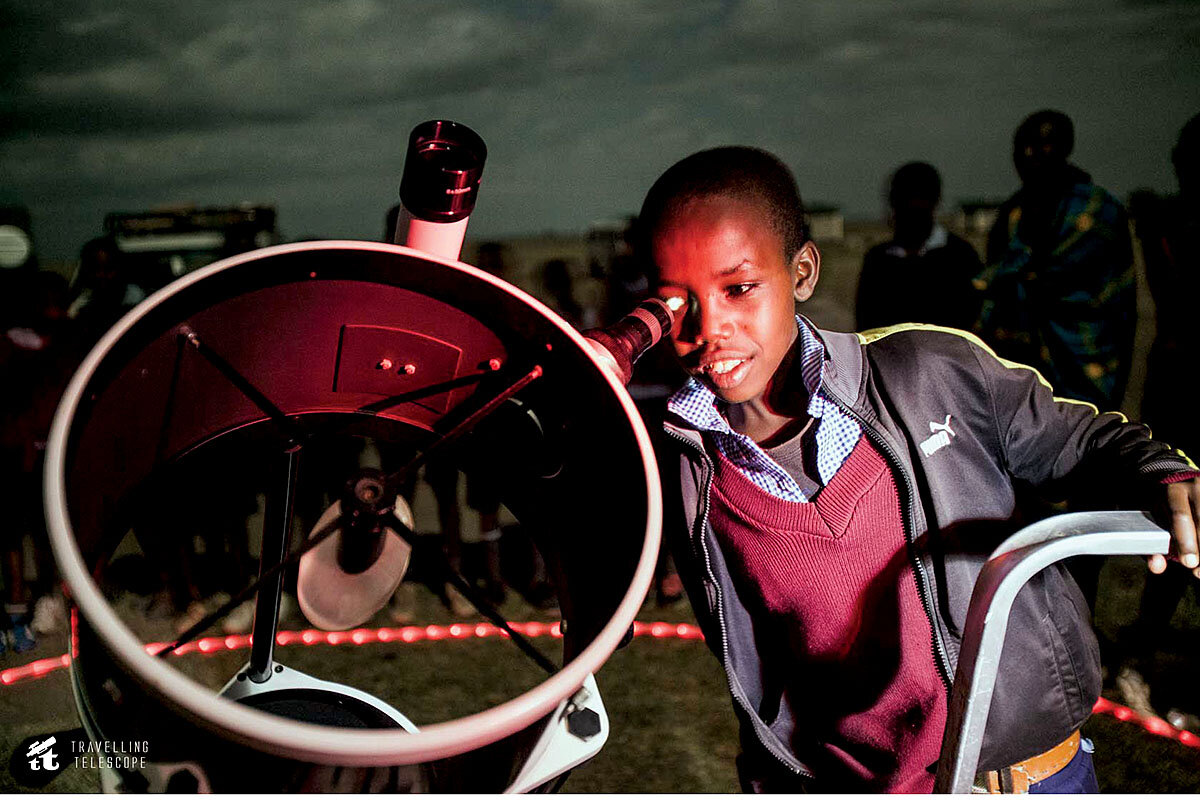
- Quick Read
- Deep Read ( 5 Min. )
Susan Murabana bought a telescope in 2014 – and has been sharing it ever since. She and her partner, Chu Owen, cart it around Kenya to show children what stars look like up close.
In a country where few students have access to telescopes, one of the pair’s hopes is to convince young people that astronomy is a science for everyone – not just white men, whose names dominate its history. But the goals of The Travelling Telescope, as they call their organization, go beyond astronomy itself. “It’s about all the different things astronomy can teach,” Ms. Murabana says: math, engineering, even design. Most fundamentally, they want to inspire kids’ curiosity about the world around them.
When COVID-19 began to shut down schools in Kenya, she and Mr. Owen tried to keep their goals alive, even without travel. They ran online quiz nights on space topics and livestreamed solar eclipses on Facebook. And in April 2021, they began offering virtual 3D modeling workshops in partnership with Airbus.
Ms. Murabana studied economics, before pursuing a master’s degree in astronomy. “I always loved math and science, but I wasn’t exposed to astronomy,” she explains. She hopes The Travelling Telescope changes that for kids today.
The Travelling Telescope brings stars to students
Susan Murabana’s traveling telescope began with a simple revelation: We all have access to the sky.
We all see the same moon. We all look up at the same night sky splattered with stars.
At the same time, she knew that access wasn’t created equal. Telescopes have been around for 400 years, but most children in Kenya, where Ms. Murabana is from, had never looked through one.
She thought she could change that.
In 2014, she and her partner bought a telescope and started carting it around Kenya to show kids what the stars looked like up close. Today, The Travelling Telescope program has reached 200,000 kids, by their count, and won the Europlanet Prize for Public Engagement for its efforts to make the night sky accessible to all. The couple have built a permanent planetarium made from bamboo in their backyard in Nairobi. And during the COVID-19 pandemic, the program has pivoted to teach kids about space and rockets online, offering workshops on 3D modeling and astronomy to local schoolchildren – who have been in and out of classrooms as lockdowns squeeze and loosen.
“It’s never been about these kids becoming astronomers – but it’s about all the different things astronomy can teach,” Ms. Murabana says. “There’s engineering and geology and math, and there’s also just an opportunity to question, to inquire, and to be creative.”
On a recent morning, a dozen kids between the ages of 9 and 16 watched attentively as Ms. Murabana and Chu Owen – her partner in astronomy education and in life – presented, along with their colleague Ronald Wasilwa, how to build a 3D model of a rocket using an online design platform.
“Can I share a fun fact I know about airplanes?” one student interrupts, and then before receiving an answer continues. “They’re like buses in the sky.”
Written in the stars?
Ms. Murabana and Mr. Owen met at a solar eclipse. It was 2013. She was volunteering for other organizations, doing astronomy classes at schools across Kenya.
“I noticed that astronomy was a science that kids got really into,” she says. Everyone wanted to know what was in the sky above them, and it was a way to package lessons about science, math, technology, and design in one.

That year, with a full solar eclipse predicted over northern Kenya, she’d received 5,000 pairs of solar-safe glasses from Astronomers Without Borders so that kids in Turkana, a region in the country’s north, could safely watch the once-in-a-lifetime event. Mr. Owen was there to make a documentary about it.
They fell in love, and then started The Travelling Telescope, taking the telescope around Kenya doing demonstrations and teaching astronomy lessons at schools.
Growing up in Nairobi, Ms. Murabana never saw astronomy as a possible career path – or even a potential hobby. The sky was a background feature in her life, not something to study or explore.
“I always loved math and science, but I wasn’t exposed to astronomy,” she says. She studied economics in college, then worked in marketing. But when she began volunteering with science outreach programs, she saw the way astronomy seemed to make kids from all walks of life light up. Soon, she was teaching kids about space through programs like Hands-On Universe and Universe Awareness, and completing a master’s degree in astronomy herself.
A science for all
Around the world, including in Kenya, astronomy has often been cast as a European science. The famous astronomers through whom many become acquainted with the study of the stars – including Galileo Galilei, Isaac Newton, and Edwin Hubble – are almost all white men. Most constellations take their Western names from Greek and Roman history.
But astronomy is also an African science. The libraries in Timbuktu, Mali, contain tomes on astronomy written between the 13th and 17th centuries. And many African cultures have historically used the stars to chart seasons and directions.
In recent years, several countries on the continent, including Ethiopia, Nigeria, and South Africa, have developed robust space programs, launching satellites and conducting astronomical research.
For Ms. Murabana and Mr. Owen, The Travelling Telescope could be the spark that sets off careers for young Kenyans in astronomy – or in geology, engineering, design, or math. Or something else entirely. The goal, they say, is less to create young scientists than to create young people passionate about exploring the world around them.

At Hillcrest International Schools in Nairobi, preparatory head teacher Surbhi Vashisht says the telescope has been a “big hit” with her students, 170 of whom have participated in Travelling Telescope workshops: looking at the stars, building rockets, and virtually exploring the landscape of Mars. “The children enjoy the energy that Sue and Chu bring to the sessions,” she writes in an email.
Stars on the screen
When COVID-19 began to shut down schools in Kenya early last year, Ms. Murabana and Mr. Owen tried to keep their goals alive, even without being able to travel.
The pair took their grant-supported work online, running online quiz nights on space topics and livestreaming solar eclipses on Facebook. And in April 2021, they began offering 3D modeling workshops in partnership with Airbus.
As kids in oversize headsets watched from inside their houses – parents and siblings puttering around in the backgrounds of their Zoom screens – the Traveling Telescope team demonstrated how to use a modeling software called Tinkercad to drag spheres and squares and triangles together to build models of houses, planes, and rockets.
Airbus had donated a 3D printer, Mr. Owen explained, which would go to whichever student created the best model rocket after the course was finished.
The dozen faces on the screen could hardly compare with the hundreds who often gathered when they took the telescope out to a rural school. And most of those kids, they knew, wouldn’t have the internet access or technology to do a 3D modeling course on Zoom.
Still, the courses were a way to keep reaching out.
As the workshop came to a close one morning, Ms. Murabana waved goodbye to the students.
“Take care, keep safe, mask up, and keep tinkering!” she said, as the screens in front of her flickered off one by one.

Survival skills: A backpack design course helps more than just hikers
Our reporter found a course in making backpacks at a small Vermont college also offered lessons in sustainability, sparked an appreciation for hands-on learning, and developed new problem-solving skills.
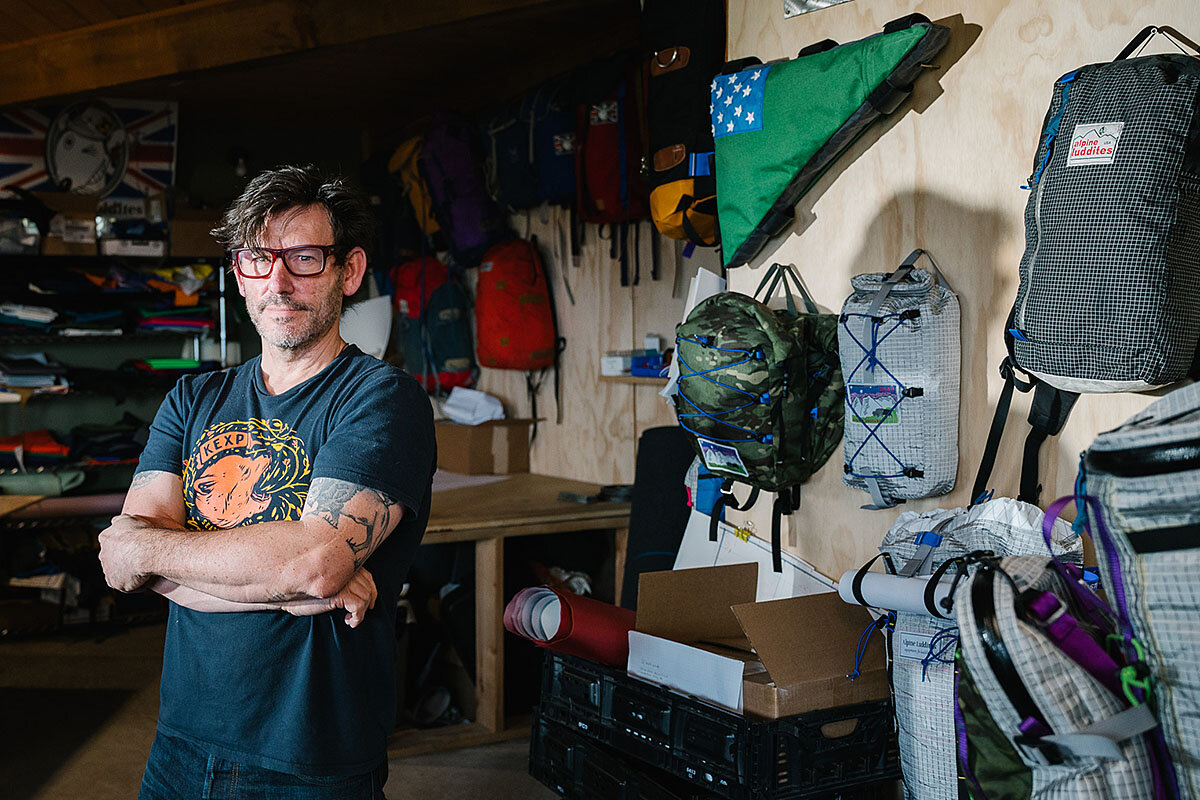
- Quick Read
- Deep Read ( 4 Min. )
-
By Gareth Henderson Correspondent
This spring, Sterling College in Craftsbury Common, Vermont, offered its first gear design and repair course.
The new class has the potential, say instructors and those in the industry, to not only help students be better prepared for surviving in the wild, but also expand both local gear manufacturing and an understanding of the design process overall.
“Everything – and I do mean everything – is designed and developed the same way: through a series of steps that visualize, confirm, and then create,” says Kurt Gray, who runs the design and product operation at Jagged Edge Mountain Gear in Telluride, Colorado. “The major benefit to the community,” he adds, “is teaching young people how to realize their dreams through the rigors of meticulous planning and application of skill.”
Guided by faculty and a local backpack-maker, students at Sterling learned in the five-week course how to make a pack from scratch and to repair items brought to them by the college community. They say the course also taught them how to be more discerning consumers of gear, with increased appreciation for what it takes to make the final product.
As Anna Weber-Loomis, an outdoor education major, notes, “It’s seeing the world in a slightly different way.”
Survival skills: A backpack design course helps more than just hikers
After scaling the heights of the Andes, Alps, and northern Rockies, John Campbell understands the importance of proper outdoor gear – and he’s eager to share that knowledge.
This spring, he taught college students in Vermont the finer points of backpack fixing – and even how to make their own product from scratch. That’s a big advantage for those pursuing outdoor careers, because it’s rarer than one might think, Mr. Campbell says.
As recently as the 1990s, many outdoor brands in the United States sewed their products locally. But Mr. Campbell, who runs his own gear business, says that’s not the case anymore, and he wants to pass along how it’s done. “These are just good skills to have,” he says.
Mr. Campbell is one of three instructors for the first gear design and repair course at Sterling College, in Craftsbury Common, Vermont. The scenic college, about 40 minutes from the Canadian border, has long focused on the environment and sustainability. The new design class has the potential, say the instructors and those in the industry, to not only help students be better prepared for surviving in the wild, but also expand both local gear manufacturing and an understanding of the design process overall.
“Everything – and I do mean everything – is designed and developed the same way: through a series of steps that visualize, confirm, and then create,” says Kurt Gray, who runs the design and product operation at Jagged Edge Mountain Gear in Telluride, Colorado. “The major benefit to the community,” he adds, “is teaching young people how to realize their dreams through the rigors of meticulous planning and application of skill.”
Early on in the five-week course, which wrapped up at the end of April, Mr. Campbell started by introducing students to his business, Alpine Luddites, in Westmore, Vermont. Students – in two groups of five due to pandemic protocols – trained on three large, industrial-grade sewing machines. Each group created its own backpack design, and from there individuals made their own packs, which they personalized with smaller parts, like daisy chains (the bumpy strips on the sides of packs), pockets, clips, and straps.
“You’re going to attach all the important details before you make the cylinder shape,” says Lydia Pinkham, an outdoor education major.
As they worked with materials to get that recognizable backpack shape, they learned what to watch out for. “One of John’s biggest things is, ‘There shall be no exposed edges,’” Ms. Pinkham says. Exposed edges can lead to the fabric catching on things and the pack wearing down, she explains.

When the students weren’t at Mr. Campbell’s shop, they were honing their new skills on the nearby 130-acre Sterling campus in Craftsbury Common, a village in the town of Craftsbury, where experiential outdoor learning has been in place for five decades.
Josh Bossin, one of the outdoor education faculty, organized the course and taught the ins and outs of repair and gear history. At his request, the college community dropped off all kinds of outdoor gear for the students to fix.
“This allows us to support our community [with] keeping things out of the landfill, and at the same time, gives my students a chance to do real-life repairs and feel the impact it has with a real ‘customer,’” says Mr. Bossin, who hopes to offer the course again in the future, possibly every other year.
Having more students learn the skills the class is offering, Mr. Campbell says, could help bring back some manufacturing jobs that were lost years ago. “I feel like at some point, we’re going to go back to local manufacturing,” he says of the outdoor gear industry.
Prin Van Gulden focused on participants mastering fundamentals like sewing in her part of the course, including a range of techniques for making repairs by hand. “My goal is for students to gain confidence and competence with the basics,” says Ms. Van Gulden, an adjunct faculty member in the area of environmental humanities. “I want them to feel undaunted, to feel empowered to deal with problems as they come up.”
Some students arrived with a bit of sewing experience. Sharing those kinds of abilities with others is something Anna Weber-Loomis, an outdoor education major, is interested in. “I feel like we’re kind of losing that by having lots of book learning and not much hands-on learning,” she says.

Tyler Kheang, a student from Philadelphia, would like to use what he’s learned to get others interested in the outdoors. “For me personally, I want to get more minorities into the outdoor setting,” he says.
These skills save money, he says, as you can repair old gear rather than buying new. And anyone can learn it, he adds. “It takes away that financial factor and makes an opportunity for everyone to be equal,” he says. “A lot of people back where I’m from don’t have a lot of money to buy expensive things.”
The students say the course gave them not only a knowledge of how to make and repair gear by hand, but also taught them how to be more discerning consumers, with increased appreciation for what it takes to make the final product.
“It’s seeing the world in a slightly different way,” Ms. Weber-Loomis says.
Other headline stories we’re watching
(Get live updates throughout the day.)The Monitor's View
The hounds of peace that could end the Gaza war
- Quick Read
- Deep Read ( 2 Min. )
-
By the Monitor's Editorial Board
In a war that hardly seemed planned, Israel and the Palestinian militant group Hamas in Gaza have begun their fourth conflict in 12 years. This week, the two sides have exchanged massive firepower, triggered by a series of violent incidents in Jerusalem. The last Gaza war in 2014 went on for seven weeks. This time, so much has changed in the Middle East and elsewhere that this war could be shorter. Here’s why:
1. A decades-old global consensus on avoiding civilian casualties during war has only grown stronger, partly through the actions of international courts.
2. Both sides have more trusted interlocutors who can help arrange a cease-fire.
3. The Middle East is in a mood for peace – and post-pandemic economic growth – with far less tolerance for Islamic radicals like Hamas.
4. Fixing their respective democracies may be more important to Israelis and Palestinians than another war.
The changed mental atmosphere of the Middle East could help de-escalate this latest Gaza conflict quickly. After three similar wars, leaders on both sides must know that a fourth one just cannot be the same.
The hounds of peace that could end the Gaza war

In a war that hardly seemed planned, Israel and the Palestinian militant group Hamas in Gaza have begun their fourth conflict in 12 years. This week, the two sides have exchanged massive firepower, triggered by a series of violent incidents in Jerusalem. The last Gaza war in 2014 went on for seven weeks and left more than 2,000 dead, mainly civilians. This time, so much has changed in the Middle East and elsewhere that this war could be shorter, perhaps even less deadly. Here’s why:
1. A decades-old global consensus on avoiding civilian casualties during war has only grown stronger, partly through the actions of international courts. Israel and Hamas may be more attuned to foreign pressure and obey the rules of war aimed at protecting innocent people.
2. Both sides have more trusted interlocutors who can help arrange a cease-fire. Besides Egypt, which controls one border with Gaza and has intervened in the past, other Middle East countries, such as Turkey and Jordan, can play a mediating role.
3. The Middle East is in a mood for peace – and post-pandemic economic growth – with far less tolerance for Islamic radicals like Hamas. Iran is talking to its regional rivals. Last year’s so-called Abraham Accords, in which four more Arab states set up ties with Israel, may have a dampening effect on Israeli-Palestinian violence At the same time, the Palestinian cause has gained more supporters in the West. All of this may allow for what Dennis Ross, a former American negotiator in the Mideast, calls the “empathy rule.”
“The more you show that you will reach out and that you do understand the other side, the more you can and should create an expectation that the other side must also understand your needs and respond to them,” he wrote in his book “Statecraft.”
4. Fixing their respective democracies may be more important to Israelis and Palestinians than another war. That’s evident by Palestinians in the West Bank not rising up against Israel during this latest conflict. A Palestinian parliamentary election that was slated for May 22 was canceled last month, angering younger Palestinians, who have been unable to express their political voice through the ballot box in 15 years. Hamas, too, is eager to hold the election, as it may win. In Israel, meanwhile, four elections in two years have left Israel’s politics in turmoil. Prime Minister Binjamin Netanyahu is barely hanging on to power.
The changed mental atmosphere of the Middle East could help de-escalate this latest Gaza conflict quickly. After three similar wars, leaders on both sides must know that a fourth one just cannot be the same.

A Christian Science Perspective
Each weekday, the Monitor includes one clearly labeled religious article offering spiritual insight on contemporary issues, including the news. The publication – in its various forms – is produced for anyone who cares about the progress of the human endeavor around the world and seeks news reported with compassion, intelligence, and an essentially constructive lens. For many, that caring has religious roots. For many, it does not. The Monitor has always embraced both audiences. The Monitor is owned by a church – The First Church of Christ, Scientist, in Boston – whose founder was concerned with both the state of the world and the quality of available news.
How I’m praying about the situation in India
- Quick Read
- Read or Listen ( 4 Min. )
-
By Annu Matthai
As news reports continue to come in about the increasingly desperate situation in India with COVID-19, a woman from Bangalore shares ideas that have brought hope and inspiration to her prayers for her country and the world.
How I’m praying about the situation in India
In the face of a global pandemic, it can be tempting to feel helpless and hopeless. We might even wonder, Can prayer really help? Yes, it can. Here in India in the midst of what seems to be overwhelming lack, loss, and fear, I’ve found help in the Bible: “Hear my cry, O God; attend unto my prayer. From the end of the earth will I cry unto thee, when my heart is overwhelmed: lead me to the rock that is higher than I” (Psalms 61:1, 2).
Through my study of Christian Science, I’ve learned that God is infinite, all-powerful, ever-present Love. This is the “rock” to which we can all turn and on which we can stand when feeling overwhelmed.
God is the refuge we can go to at any time, where we can shelter in His love for all. God holds us, and everyone, up forever, and even in the most trying circumstances, God is our place of safety. God, our divine Parent, is tenderly mothering – caring for – each of us, and lovingly providing spiritual ideas that translate into practical solutions for every human need. The Bible is full of examples of reliance on God providing help and comfort in situations of human need, including from hunger, disease, danger, and death.
In the Christian Science textbook, “Science and Health with Key to the Scriptures,” Mary Baker Eddy writes, “Divine Love always has met and always will meet every human need,” and she assures us of the spiritual fact that “to all mankind and in every hour, divine Love supplies all good” (p. 494). It may feel like a huge leap of faith to say this when the situation looks so bleak. But we catch glimpses of God’s love through the many people who are acting with kindness, generosity, and unselfishness to help those in need.
It’s been both extraordinary and heartwarming, for instance, to see the ways in which individuals have felt compelled by love and to help others who need specific help but don’t have anyone to provide it. And as stated in an editorial in The Christian Science Monitor on May 7, 2021, there are “millions of volunteers and small-scale donors who are assisting sick and destitute people during a COVID-19 wave.
“For a country that has long ranked relatively low in charitable giving, India is coming on strong in weaving new levels of public trust” (“How India lightens its crisis”).
These kinds of acts are evidence of the Love that is God. This Love fills all space. It is the all-pervading atmosphere in which we all truly live. Divine Love’s presence is filled with life-giving ideas, freely available to all. We each have an inherent ability to inhale, to take in, these ideas and allow them to purify, cleanse, and heal fear, discouragement, or dismay – anything that would overwhelm us.
The inexhaustible supply of inspiration pouring out from the infinite source that is God’s goodness is the spiritual “oxygen” that we breathe and that sustains us all. This inspiration is the Christ, “the true idea voicing good, the divine message from God to men speaking to the human consciousness,” as explained in Science and Health (p. 332).
Nothing can obstruct this divine message or even delay it. God is all-powerful, and knowing this helps make solutions apparent to people everywhere – so that those who need it most can feel the comfort and strength of divine Love’s inspiration right where they are. No matter how difficult the circumstances, God’s perfect love takes away fear. It calms us and enables us to think clearly. Helplessness and vulnerability give place to an assurance of safety that ripples out to calm those around us.
Divine Love’s universal law governs impartially. Under this divine government, supply and demand are perfectly balanced. No human barriers or dividing lines can withstand the power of God’s love to reach everyone. Nor does Love’s law penalize those who are doing good. The health care workers and others who are so selflessly giving of their skills, time, and resources can affirm their right to see Love’s divine law blessing their willingness to help and protecting all engaged in good work. This is the most powerful protective equipment available.
Over the years, I’ve turned to God as the “rock” of divine Love and consistently found comfort, strength, and healing in my life. So, I am confident that even with what seems to be a problem of great magnitude, our prayers will have a sure healing effect, helping to bring an end to the current crisis in India and the pandemic around the globe. A favorite hymn assures us:
Everlasting arms of Love
Are beneath, around, above;
God it is who bears us on,
His the arm we lean upon.He our ever-present guide
Faithful is, whate’er betide;
...
He will keep us all the way,
God, our refuge, strength and stay.
(John R. Macduff, “Christian Science Hymnal,” No. 53, © CSBD)

A message of love
Fleeing Mideast violence

A look ahead
Thanks for joining us. Come back tomorrow: We’ve got a story about conservative Christians and LGBTQ rights activists finding ways to work together in the third installment of our Respect Project.




